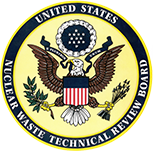
Most of the spent nuclear fuel generated in the United States comes from the operation of commercial nuclear plants, U.S. Department of Energy (DOE) operations, and defense activities. Spent nuclear fuel from the operation of commercial nuclear power plants is managed by the operators of the plants, while DOE manages spent fuel from its own operations and defense activities. High-Level Radioactive Waste results from the processing of spent nuclear fuel. DOE manages all high level waste in the United States. The main types of high level waste are liquid waste stored in underground tanks, vitrified (waste that has been immobilized in borosilicate glass), calcined waste (a powder produced by drying liquid high level waste at high temperature), and capsules containing cesium chloride or strontium fluoride (radioactive material separated from liquid high level waste stored in tanks at the Hanford site).
Under the Nuclear Waste Policy Act (NWPA), as amended, the U.S. Nuclear Waste Technical Review Board is charged with evaluating the technical and scientific validity of activities undertaken by DOE under the NWPA related to managing and disposing of spent nuclear fuel and high level waste.
READ MORE:
Examples of Board activities related to radioactive waste:
- BOARD REPORT - Evaluation of the U.S. Department of Energy Research and Development Activities on the Disposition of Commercial Spent Nuclear Fuel in Dual-Purpose Canisters, February 2024
- BOARD REPORT - Six Overarching Recommendations for How to Move the Nation's Nuclear Waste Management Program Forward, April 2021
- BOARD REPORT - Management and Disposal of U.S. Department of Energy Spent Nuclear Fuel, December 2017.
- FACT SHEETS - DECEMBER 2017:
To see a full listing of fact sheets related to SNF and HLW see Fact Sheets.
To see a full listing of the Board's activities, please visit OUR WORK on the menu.
